Engine Room Opens Penthouse Studio In New, Expansive Financial District Facility
LOWER MANHATTAN: In all incarnations, including its latest, Mark Christensen’s Engine Room Audio has run ahead of the curve, taking risks to provide the local artist and producer/engineer community with something it really needs. Back in ’03, Christensen opened a multi-room production and mastering facility on Canal Street, making high-quality, acoustically designed rooms available for long-term lease to producer/engineers, songwriting teams, composers, etc. There was an immediate waiting list.
Now, with the opening of a brand-new, large-format tracking and mixing studio located in the penthouse of its year-old, 11,000-square-foot financial district facility, Engine Room again goes out on a limb and the result is again huge for the community.
At its core, Engine Room is a DIY-inspired enterprise, and this latest move sees Christensen, a Grammy-winning engineer, producer and songwriter, realizing a nascent vision.
“When I started the first Engine Room Audio, I was technically still signed [to a record deal] and owed the label another album, but I’d gotten so fed up with everyone telling me what to do; I really wanted to be able to do my own thing,” Christensen recalls.
“I wanted to build a facility where I could record, mix, master and even manufacture and release my own records without being forced to do anything I didn’t want to. And ultimately I wanted to be able to offer that to other artists.”
He started with a home studio, moving a Trident board and CD manufacturing facilities into his East Village apartment, and quickly found a lot of clients in like-minded NYC artists. Christensen built a name for himself as a mastering engineer and expanded his business with the WSDG-designed modular facility on Canal Street.
Yet with all of his production rooms always leased out, and a new record label — Engine Room Recordings — beginning to get some traction, Christensen longed for a full-blown studio where he and his growing community could produce and mix albums at the highest level.
This spurred another move all the way downtown to 42 Broadway, where he took over the entire top floor and penthouse and began his most ambitious build-out to date. The new location is home to Engine Room Audio and Engine Room Recordings, encompassing eight production suites, Christensen’s mastering facility, and the big penthouse studio as the cherry on top.
“If we were going to have a nice space, then I wanted it to have all of those things that a really nice studio should have,” says Christensen of the penthouse, “including a tuned control room with nice big far-field monitors as well as the nearfields so you can tell what’s going on in the sub frequencies. I wanted to build as pro a studio as we could.”
A DELUXE STUDIO IN THE SKY
In all, EngineRoom’s sprawling facility incorporates nine control rooms, including seven in long-term lease situations housing the likes of producer/engineers Bill Racine, Paul Falcone, DJ Cassidy and J. Chris Griffin among others. The eighth studio houses some of Christensen’s gear — including Pro Tools HD and an Amek console — and is setup for tracking and mixing sessions. The rooms are all big enough to comfortably house a mid-sized console and everyone has their own booth.
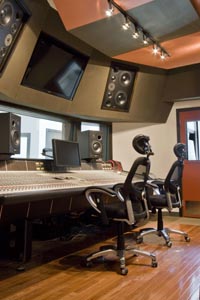
The penthouse control room w/ SSL 4064 G+ console and Dynaudio M4 mains. Photo by Heather Smith-Prisco.
Every control room is also tie-lined into the new two-story live room up in the penthouse — a large, full-band tracking room with two large isolation booths. A third iso booth is located off the corresponding control room, which features an SSL 4064 G+ console, Dynaudio M4 main monitors, stacked producer’s desk and spacious listening area.
It’s the studio he’s always wanted to build — a deluxe A room with ample space maximized by sightlines and natural light. From the control room, Christensen points to the outdoor surface area, soon to be a roof deck. We’re on the 22nd Floor and it’s a sweet view.
“These rooms are all floated and it’s all triple-rock, ¾” plate glass everywhere,” says Christensen. “The isolation is hard-core. We wanted to have good sightlines and natural light everywhere, but we didn’t want to have too much glass, so that was a big challenge Chris Bowman solved in the design.”
A longtime friend and colleague of Christensen’s, Bowman and his CHBO, Inc. have contracted and built many a studio in the NYC area, including the Canal Street Engine Room and the Fran Manzella-designed Sterling Sound. “I’ve absorbed as much as I could from him over the years, so that now we can work together really well, with Chris focused on the layout and look and me on the acoustics from a mathematical perspective,” says Christensen of their collaboration on the penthouse studio.
“The construction of the control room relative to the live room is such that — in theory — we can do two sessions up here simultaneously. We’re going to add shutters to the windows between the two rooms, so if someone’s doing a mix in the control room, or vocals in the booth, someone else could be tracking out in the live room, recording down to one of the production rooms.
“Obviously we won’t do this with, say, John Williams and the Ramones, but if people are somewhat cooperative, it seems like it will really work. A drummer can be pounding away in the live room and you don’t hear it at all in here.”
The SSL 4000 Series console, which Christensen points out “is the model that’s historically, mixed more hits than all other consoles combined, ever,” comes to The Engine Room from The Franklin House in Nashville.
“We’re only the second owners,” Christensen notes. “Still, any vintage console needs work. My head tech Pawel Szarejko shares my insanity when it comes to electronics and — even though this console was in way better shape when it came through the door than other consoles I’ve worked on around town recently — we’ve begun recapping the entire thing. It already sounds great, but will be awesome when we’re done with it!”
ENGINE ROOM’S MANY MOVING PARTS
Engine Room is far from a build-it-and-they-will-come dream studio. Good thing, too, as the timing of all this building couldn’t have been much worse. “October ’08 practically put us out of business,” Christensen admits. “We lost all of our construction financing with the economy crashing, and then that was compounded by the typical problems you face building a facility like this — a lot of the construction estimates were miles off the mark.”
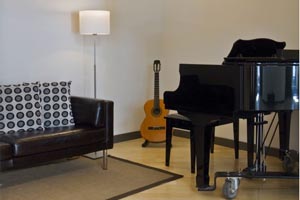
Every control room in the facility ties into the penthouse live room. Photo by Heather Smith-Prisco.
Built for an already ailing industry, however, the business plan for the space was solid. In addition to the tenant control rooms, Christensen also built out the rest of the floor, with his other company Space Initiatives, to eventually house additional tenants whose studios could also tie into (and therefore subsidize) the penthouse. NYC’s Dubway Studios took him up on this arrangement.
“Dubway will have their production facilities downstairs, including three decent size studios with booths, and they’ve effectively bought 25% of the monthly studio time in the penthouse,” Christensen explains. “I’ve known Mike [Crehore] and Al [Houghton] for a long time; it’s a great fit.”
When we visited Engine Room in August, Dubway had just begun renovations on their new facility in this space, and will be moving down from 26th Street. With Dubway moving in, the facility will be home to that many more of NYC’s top-level music production talent. This is just the kind of world Christensen’s been working to create all along.
“One of the coolest aspects of Engine Room is the huge community,” he acknowledges. “We all talk about bands, production techniques, we borrow microphones from each other, etc. It’s an amalgamation of all these cool people, creating this community where cool things are happening. It gets back to my original impetus for starting the Engine Room, it’s not like I was trying to escape the music industry and do everything myself, alone, it was more that I was trying to reinvent it, recreate it in some way.”
Engine Room Recordings, the record label Christensen founded with singer/songwriter Peter Block, is another sign that he’s no longer “trying,” he is reinventing, recreating.
Counted on the Engine Room Recordings roster are several NYC-based artists including Tracy Bonham, Jody Porter (of Fountains of Wayne), The Bloodsugars, Porter Block, Robbers On High Street and Luke Wesley.
On the day of our visit, the Brooklyn-based folk-rock band Lowry was in the studio working on a new album for Engine Room Recordings. “Lowry’s last record sounds good, but they’ve never had the opportunity to record in a facility like this,” says Christensen. “We’re doing this for the love of the music and since we can handle every aspect of it in-house, we’re able to take the time to make a really great record.”
THE PRODUCER’S PERSPECTIVE
Now that he has his proper studio, Christensen is also finding time to produce, as on dance-pop duo Hank and Cupcakes’ latest EP. Though he’s got golden ears and plenty of mastering clients, Christensen is still that rock-and-roll singer/songwriter looking to give a band what he was always looking for as an artist.
“When I produce, I’m all about the songs,” he assures. “If you have great songs and great singers, you can record a great album on a cassette player from Kmart. I am pretty specific about the sound as well — the fidelity — but not in some weird, audiophile kind of way. I just want the record to have a sound. Like Bon Iver’s [For Emma, Forever Ago] — that record sounded amazing even though it was clearly not recorded at some expensive studio. It’s not about having a million-dollar sound, the music just has to be present somehow.
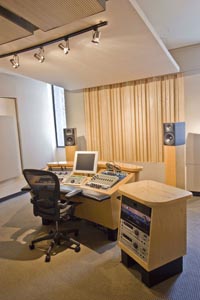
Mark Christensen's new mastering studio within the Engine Room complex. Photo by Heather Smith-Prisco.
“I try to make all of that effortless to the band though — they should be concentrating on creating art and energy. When you have great gear and a great room, that stuff becomes a lot easier to capture.
“As a mastering engineer, I’ve really come to understand how important the sound of the room that you’re both listening and tracking in is — it’s just such a massive part of what you do. If I had the choice between the most expensive mics in the world in a crappy room or crappy mics in a great room, I’d definitely choose the room every time.
“So that was part of my motivation for making as good a studio as we could upstairs, so we could actually tell what’s happening in the kick drum, for example. I can’t tell you how many records I’ve mastered even for major labels where the whole thing was tracked and mixed on nearfields and they had no idea what was going on below 70 Hz. And there’s all kinds of stuff down there that’s really coloring it. To some extent you can save that in mastering, but it makes more sense to actually be able to hear what the kick drum is doing while you’re tracking.”
Engine Room’s new studio is open for business, and has already hosted OK Go, Ryan Leslie, Trey Songz, Raekwon and several others. Get in touch via http://engineroomaudio.com/contact.
Please note: When you buy products through links on this page, we may earn an affiliate commission.







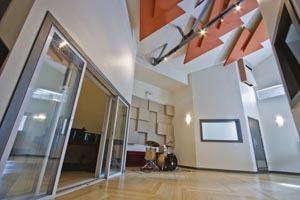
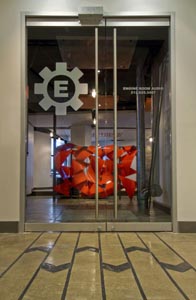
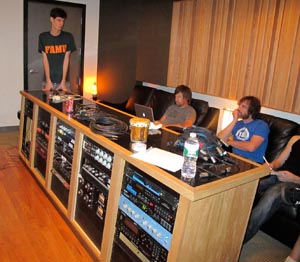
Wesley Verhoeve
September 10, 2010 at 4:47 pm (14 years ago)Great article! I’ve done a lot of work with Engine Room Audio and their mastering and recording facilities have never disappointed!